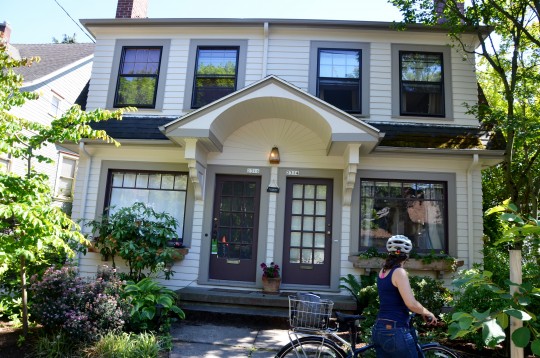
(Photos: M.Andersen/BikePortland)
Most of Portland’s conversation about ways to create enough new homes to defuse our deep and ongoing housing shortage has focused on the four-story apartment buildings rising along a few main streets.
But there’s a growing awareness in Portland’s housing policy community that low-rise apartment buildings — let alone the taller buildings rising in the Lloyd, Burnside Bridgehead and Pearl — aren’t the only buildings that can increase the supply of housing in the walkable, bikeable parts of Portland. In fact, the other options might be more popular with neighbors, too.
The only problem: in almost all of Portland, creating such buildings is forbidden.
They’re called duplexes.
Last weekend, Portland micro-developer Eli Spevak led 20 people on a Pedalpalooza ride called “The Missing Middle,” focusing on what Spevak sees as the forgotten stepping stone between Portland’s sleepier, yard-and-driveway past and the bustling urban future being built on SE Division, North Williams and elsewhere.
Spevak borrowed the phrase from Berkeley-based Daniel Parolek of Opticos Design, whose website MissingMiddleHousing.com promotes many classes of housing that were popular in the cities of the early 20th century, but largely eliminated when the modern age of auto-oriented urban planning arrived.

When Portland’s first zoning plan was approved in the mid-1920s, local planning historian Steve Dotterrer said, what we now know as “single-family” zoning “was only applied in Laurelhurst, Eastmoreland, Overlook and a little bit of the West Hills. Everything else [away from rivers and streetcar corridors] was Zone 2, which allowed any kind of residential, from high-rise to single-family.”
High-rises, always expensive, were built only in the very heart of the city. Multiplexes, though, became common.
“But in 1959 the code was completely rewritten and for the first time autombile restrictions came in,” Dotterrer said. “The single-family zones were actually expanded to cover lots of the city.”
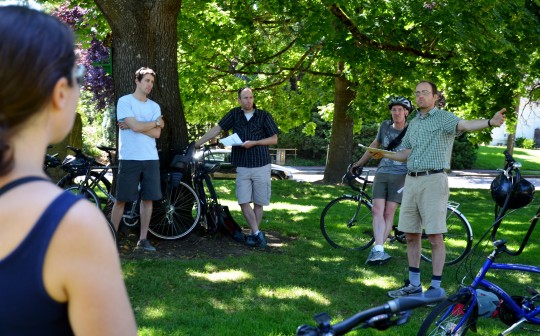
Fortunately, Portland’s bike-friendliest neighborhoods still retain a memory of this sort of housing — because it’s still very much in use. In fact, these are the housing units that Portland’s bike-friendliest neighborhoods are built on.
Not only do these buildings tend to cast shorter shadows and offer more bedrooms. Because they’re only one to three stories tall, they can be built with wood frames, which makes them significantly cheaper to build than taller concrete or steel apartment and condo structures.
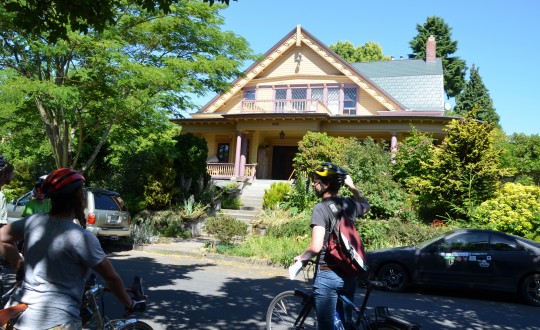
During Sunday’s ride, Spevak led participants around a few blocks of inner Southeast and Northeast Portland, showing off building after building that would be illegal if it were built today, but remains in so much demand that nobody has wanted to use it for anything else. In some cases, they seemed likely to be the most affordable homes remaining in this part of Portland.
And maybe even more remarkable: they fit right in.
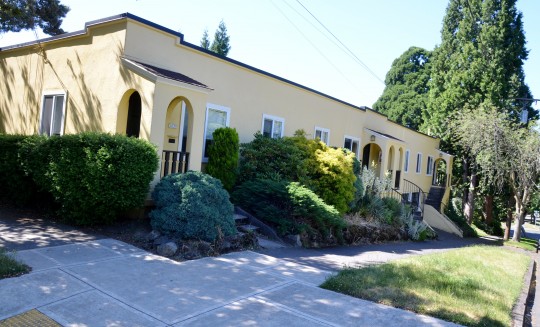
To be fair, these duplexes, four-plexes, internally divided homes and courtyard buildings weren’t small, and may well have changed the feel of the neighborhood when they were built. But compared to a three- or four-story apartment block, they’re next to nothing.
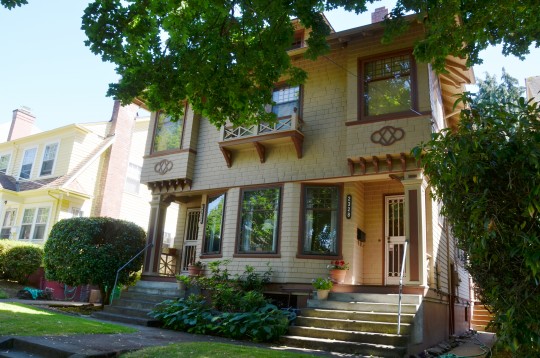
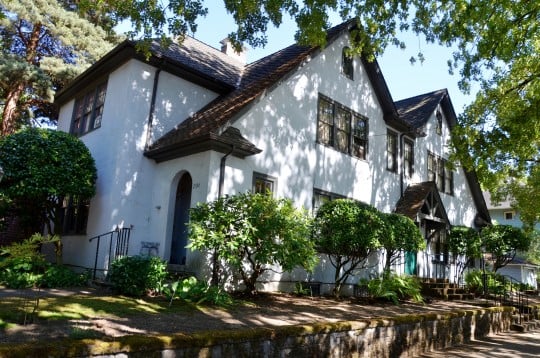
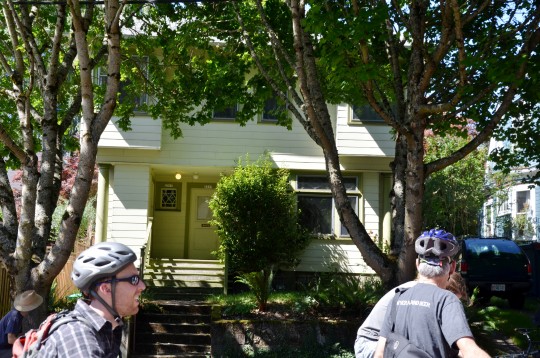
Today, Portland’s most common residential zone, R5, allows duplexes in only one situation: when they’re on a corner lot and one door faces in each direction.
It’s easy to see how, if the city were to re-legalize mid-block duplexes and internal home divisions in residential neighborhoods, central Portland could gradually absorb thousands of these small but often family-sized units without massive changes to the way the city looks or works.
Advertisement
Spevak also argues that legalizing such buildings could reduce 1:1 demolitions by making it more profitable for developers to add units inside existing houses rather than tearing old ones down.
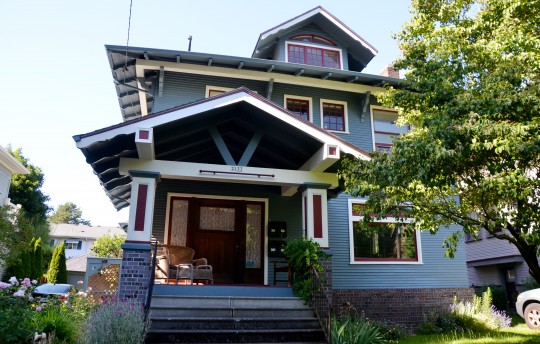
While looking at all these older homes, it’s worth keeping in mind that Portlanders built cheap, flimsy homes in the 1920s, too. We don’t see very many of those because they’ve all been torn down by now. The best-built homes must have cost a fortune in those days; decades later, they’re often the best bet for an affordable home in Portland’s much-loved middle.
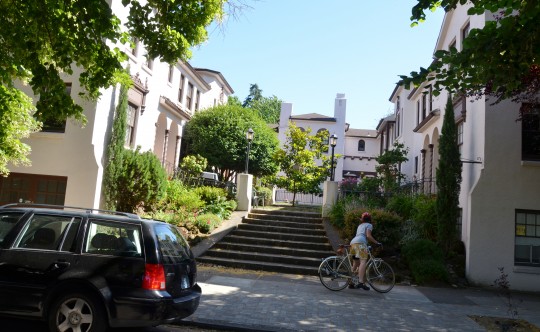
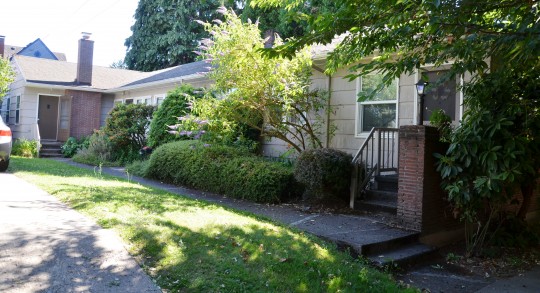
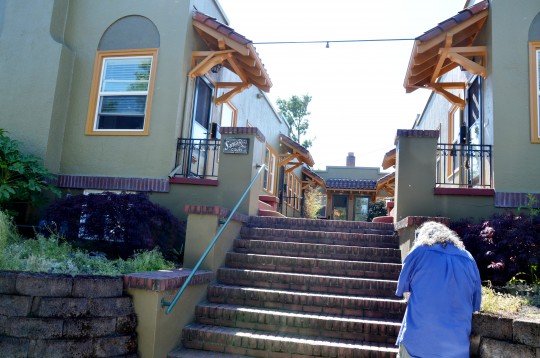
Here’s an extra bonus home we stopped at during Sunday’s ride. It’s not attached to any other home. Can you guess why it’s illegal?
Scroll down a bit for the answer.
.
.
.
.
.
.
.
.
.
.
.
.
Not enough car parking.
For decades, city code has forbidden the first car length away from the sidewalk from being the only auto parking space on a single-family home, except in the case of single-family homes that sit within a block or two of frequent transit lines. According to city filings, a local green architect went through a special design review process in 2007 to persuade the city to waive the extra parking space requirement as part of his extra-low-impact home.
Would it be possible for Portland to re-legalize homes like the ones above? Maybe.
Responding to spiraling housing prices and residents’ worries about increasing home demolitions, the city is in the early stages of amending its code for residential infill. And next Tuesday, the Portland Planning and Sustainability Commission will discuss how and where Portland is going to fit new residents over the next 20 years. If you’d like to comment on whether some of the housing types that have made central Portland what it is should be re-legalized, you can email psc@portlandoregon.gov before then.



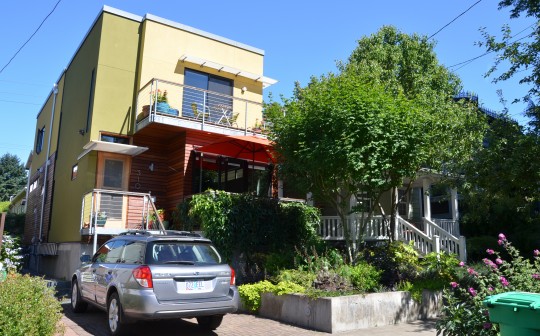
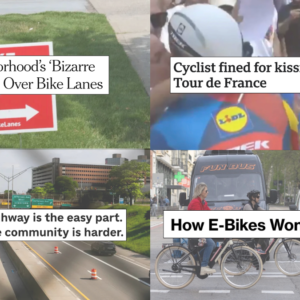



Thanks for reading.
BikePortland has served this community with independent community journalism since 2005. We rely on subscriptions from readers like you to survive. Your financial support is vital in keeping this valuable resource alive and well.
Please subscribe today to strengthen and expand our work.
Excellent! I sent an email to psc@portlandoregon.gov
I live in a triplex – works great, but make the shared walls thick!
Great coverage and a really fun ride. As someone pointed out on Sunday, opening up housing rules to allow Missing Middle types doesn’t guarantee that beautiful examples like this would result, but we’ll never know as long as they are illegal.
Minor wording quibble about your quiz: in 2007, the City allowed the architect to modify the *location* of the off-street parking space. That is, they allowed it to be in the front setback, which is usually forbidden. It doesn’t look like he asked for a waiver of the *quantity* of parking, i.e., 1 per house.
Thanks, Ben. But isn’t a one-car-length setback requirement a de facto parking minimum? It’s not as if people don’t constantly use that sidewalk driveway parking space as a parking space if they have it.
Quantity and location: two different requirements. The default would have been to put 1 required space on site, and that space can’t be in the front setback. The purpose is to make the pedestrian experience more pleasant and not have it be the butt end of cars all along the sidewalk. On this small and narrow lot, it would have been really difficult to do that without a tuck-under garage, or setting the building back another 20 feet.
They could have, but didn’t, ask the city to waive (“adjustment” in city lingo) from the 1 space per unit requirement. Obviously the “not in the front setback” locational requirement wouldn’t apply in that case. But evidently, the designer or the client wanted to have an off-street space, so they only asked for a change in where that space could be located.
The locational requirement is in 33.266.120.C: http://www.portlandonline.com/auditor/index.cfm?c=28197&a=53320
Zoning nerds — wonk out!
While I understand the intent, I would rather walk along the backsides of cars than have garages dominating every new home.
That’s not really supposed to happen either. Rules say garage doors can not take up more than 50 percent of a house’s front facade, and that the front door must be recessed no more than eight feet behind the front wall. Mayor Hales led the charge for that rule change when he was city commissioner, back in 1999.
I was walking by a house the other day and they had 6 cars in their driveway, two of which were blocking the sidewalk completely. As I was walking by, someone parked in front of the driveway.
The requirements for parking are pretty ludicrous. The house I live in has room for about 4 cars in the garage + driveway, but it is normally only used by 1 car (my roommate’s car) and ~7 bikes in the garage. No one ever parks in the driveway in case someone needs to get out of the garage (even though there is a ridiculous amount of space to go around), and the neighbors complain about “their” parking spots being taken up by our house guests.
Pretty recently, one of my neighbors came over to my house and demanded to know who parked in “their” spot and then watched our house to see if anyone was coming or leaving so they could berate them.
In response, I’m begging the city to turn the whole street into a bike corral. That will teach them to whine about parking for their cars when there is no bike parking.
Anyway, back on the topic: I see these kinds of middle houses a lot (my friend just moved into one), and they are pretty cool. If people could learn to share, these housing units would be great to have more of in our city.
Your neighbor sounds like a real piece of work. He/she needs a hobby. Sheesh.
She definitely does. Her and her family have several HUGE SUVs that are parked all over the street, mostly facing the wrong way.
Her favorite activities include: standing in the middle of the street and yelling about whatever is bothering her at the moment, yelling at her children, driving said children around constantly, yelling at neighbors for parking anywhere near her house, etc.
Just to mess with her, anytime I take a Car2go back to my house, I end up parking directly in front of hers. It’s a public street. She can get over herself or demolish her house to make room off-street for their multiple large vehicles.
use the PDX Reporter app to report vehicles illegally parked the wrong direction on the street…
dang give me a break. Yes we get it you dont like cars and everyone should ride bikes. And report your neighbor for a wrong way parked car? Now who is being petty…
When we first moved to Portland, my husband would moan about people taking my parking spot out the front of our house. I stated quite simply that it is a public street and anybody is allowed to park there. That was the last I heard about it. Yes, it is nice to be able to park on the street outside your house, but it is a public street, it belongs to the city and the city gets to determine who may and may not park there.
I really don’t understand why single family homes are required to have a double length driveway. That seems so silly. My wife and I LOVE our 1909 4-plex in Kerns. And since biking is so easy in our neighborhood, the 6 people living in our building only have 2 cars between them.
Kerns is a nice neighborhood. One of my friends just moved out and I’m going to miss visiting her. Although, now she lives in Buckman, so she’s just a slightly farther bike ride away.
Aren’t the skinny houses kind of duplexes? just with a 4′ gap between the two units (much appreciated since I lived in a triplex years ago), I know many (skinnies) are being built out here in the midland East side Portland.
Also isn’t the ADU’s also leaning towards multi family units within one. ADU’s aren’t just tiny homes, often they are converted attics, basements, and garages?
The side setbacks of skinny houses (usually 5′ on each side of a fence I believe) are just wasted space. They are usually full of weeds because who really wants to use a 5 foot wide by 50 or 60 foot deep side yard. I hate it when I see 4 skinny houses built side by side because it would be so much more efficient to have well built townhomes with no wasted yards in between. This is more energy efficient and costs less to maintain as there are fewer exterior walls. Plus it allows for a larger back yard that can actually be enjoyed for the same square footage, or you could easily add a bedroom per home with all the extra square footage.
You make a good point that I agree with (I bumped heads last year on my setback with our building department, as I wanted to mount an exterior instant water heater, and it was even at the second story level and well out of street view). Many housing requirements (such as height restrictions and side setbacks) are the result of fire reviews, though. Modern building and electrical codes have undergone sweeping changes as a result of historically large fires and earthquakes, such as those in London, Chicago, and San Francisco*. Just speculating that side setbacks may be deemed necessary for firefighters to easily access all sides of a building.
*Not sure about Boston’s great molasses flood or London’s beer flood… 😉
Most residential construction isn’t fire rated, and the building codes require that non fire rated walls be a certain distance from property lines. However if a wall is fire rated it can be right up against the property line. There’s therefore no justification for a zoning code to require side setbacks on the basis of fire protection.
This is for ‘structures’, such as sheds & garages, in Portland:
“The building code does not restrict placement of a structure on the lot, but it does require that if a structure is close to a property line, it must be constructed to a greater level of fire protection. Construction within three feet of a property line that you share with a neighbor (not a street or public alley) is required to be fire rated.”
Garage walls are required to be fire-rated with 5/8″ ‘fire rock’ sheetrock, with an additional inner layer of plywood sheeting on all walls separating car garages from living spaces.
But my point is that, historically, separation between dwellings was mandated to allow some separation from flames between houses, and more importantly to allow fire personnel to move hoses all the way around the structures. Building heights were determined by the length of ladder equipment (at the time). On paper, that is, but you can look all that up for yourself.
I’m definitely not for skinny houses all over the city. But a duplex sure seems like a much better use of space, rather than the 4-6 foot dead zone between them.
Granted developers can get more money for a “detached” house, so there is little incentive for them (even if the code allowed for more duplexes).
I’m not for large detached single family houses all over the city.
I’m shocked…….
Amsterdam has skinny houses all over their city and look how beautiful it is.
I wasn’t saying that skinny houses were as good or as efficient as far as useful real estate. Just pointing out that the duplex concept of two units on a single lot is still in play in town.
Personally I don’t really like them much, but that is a matter of taste. And I don’t really think personal aesthetics should be considered much on housing issues.
I can grow a whole lot veggies on a 5′ x 50′ space (square foot gardening method) so It’s not useless. I think that most of that space is wasted has to do more with the likelihood that people that buy them like the lack of responsibility needed to do the upkeep on a larger lot. Often the lack of a yard is counted as a selling point for these units, no one really likes mowing the lawn and weeding – I know I’m not looking forward to it once the kids leave the house.
Except most of those strips are right next to a 6 foot fence (and the house on the other side), or a strip between the house which sees very little (if any direct light).
Skinny houses almost never represent 2 homes on 1 lot, the lot is partitioned, at which point the city gets a bunch of cash from the developer and then each home is built on its own lot. I wonder if part of why the city doesn’t want to allow duplexes is that it would reduce their income from development fees, although it seems like they could just restructure some part of the fee to make it revenue neutral.
I’ll bet the reason is zoning — most are in zones that allow one house per lot, and require a 5′ side setback. I agree that the outcome is ugly and ridiculous, and I’ve never really understood why the city allows one and not the other.
In Canada they created a houses called “link homes”.
Basically a duplex but only linked at the basement level. Above ground there are separate outdoor walls. Solves the issue of noise transfer between living spaces.
We can also solve the issue of noise transfer between walls by building better buildings. When I lived in a newer apartment in Germany, it amazed me how quiet it was. Couldn’t hear a thing on either side. Here in the good ole’ US of A, I can hear what TV program my neighbor is watching downstairs.
This should be in the building code! If there has to be a firewall between an attached garage and the main house, why can’t we require an acoustical isolating wall between two units? Seems like it would increase the desirability and value of rowhouses.
The building code does have minimum requirements for sound control in walls and floors between units. It is however a minimum, and developers can choose if they want to go beyond that or not. In high end condos they typically do; in lower end rental units they don’t.
No, I’ve never seen a developer choose to go above the minimum requirement, which is STC of 50. In 30 years of renting and condo living, I have never seen above a 50 in the blueprints. The internet will tell you this is a good number that blocks most noise, but for those of us who actually live with it, it means we can hear our neighbor sneeze. Live underneath a unit and your life is a living hell of footsteps, laundry, dishwashers, toilets flushing and muffled conversation.
Actually it’s pretty easy to build a nearly sound proof wall. Use 2×8 for the headers and base of the framing then offset the vertical 2×4 studs on either side. Then you snake a layer insulation between the two sets of off set vertical studs, and add some more to fill out the gaps. Using two types of insulation improves sound proofing. Or using a larger width header and footer with insulation and an air gap.
By breaking up the continuity of the vertical studs between the wall surfaces, the only direct path for sound to travel is in the headers and footers.
This how many of the walls in theaters are built (or at least the ones I’ve helped build) but it also likely costs nearly twice as much as a standard wall in materials and labor.
I’ve built exterior bathroom walls with this technique and it works pretty well. Sandwiched between the studwalls I use fiberboard, and it deadens the air transmission pretty well (most sound transmits through the wood, as you illustrate). My condo conversion was built this way originally, and separation between side units is pretty good. Floors, on the other hand…
In Germany you most likely had thick concrete walls. In the US, we typically have wood walls which, even if they are insulated, seem to conduct sound very well.
one benefit is that there’s no cars blocking your view down the street as you’re leaving your driveway… you don’t have to creep out and block the sidewalk while checking to see if the street is clear…
however, since everything became car-centric we moved the garage from the rear of the house to the front, making the main feature of most houses the large garage door… now suddenly people are blocking the view with their cars because they have nowhere else to put it…
“Today, Portland’s most common residential zone, R5, allows duplexes in only one situation: when they’re on a corner lot and one door faces in each direction.” Oh! That helps explain the structure of my house, which has an attached mother-in-law unit with the door/address on a different street. We have two other similar houses in my neighborhood.
I love Portland’s one-story garden apartments, and they would probably be my ideal dwelling, in that I don’t really want anything bigger than a one bedroom apartment, but would like to have some green space outside and nobody living above me.
If multifamily dwellings that were only 1 to 2 stories were legalized on the side streets, I think that this could potentially increase our housing supply at a much faster rate, given that fourplexes, townhouses and garden apartments don’t take very long to build. For example, I live in the Gulch near the Lloyd Center, and I recently saw a quarter block of four townhouses built to completion within two months. In contrast, they have been building the mid-rise Hassalo apartments kitty-corner from the Lloyd Center for over a year and a half now, and they still aren’t quite done. They have two more massive complexes planned in that area, but they will likely take at least another year and a half to build. Additionally, the construction costs of such massive buildings essentially mandate that the units be sold/rented and high prices in order to even break even, much less profit.
I’m not sure if legalizing smaller multifamily units on neighborhood streets is more or less politically feasible than what we are currently doing. Neighborhood groups have a tendency to oppose anything new, regardless of how benign it might be, but they’ve obviously been incapable of effectively opposing recent developments on the main streets, so perhaps the time is ripe.
“While looking at all these older homes, it’s worth keeping in mind that Portlanders built cheap, flimsy homes in the 1920s, too. We don’t see very many of those because they’ve all been torn down by now.”
Michael, where would these have been? Most of the more established neighborhoods in town were prior to that, and there are MANY houses that are at or nearing 100 years old now.
Well, eminent domain brought a LOT of them down in the 50s-60s.
For 84 and 405?
Possibly also urban renewal. My understanding is that the Lloyd Center area used to be predominantly residental, but it was all the rage back then for cities to designate certain central areas as “blighted”, demolish every house, and replace them with office towers, shopping centers, parking lots, convention centers and parks. It didn’t really work out like they hoped.
Lower Albina was pretty destroyed by urban renewal for the construction of I-5 and Memorial Coliseum. However as best I can tell most of the land the Lloyd Center itself is situated on never had houses on it prior to the mall’s construction. Here’s an aerial photo of it taken in 1950 http://efiles.portlandoregon.gov/Record/1687957/File/Document
Interesting. I stand corrected. I have also heard that that area just south of Keller Auditorium where those brutalist 60s era concrete residential towers used to also be mostly low rise housing, although at least in this case, they replaced housing with another kind of housing, even if far uglier.
Although now that I look at the photo again, it looks like there were plenty of houses on 6th and 7th just east of the Lloyd Center and all the way down to Halsey just north of it. They must have done a fair demolition job there too, not directly where the mall is, but surrounding it.
I went to the old Holiday School on 7th from the mid 50’s to early 60’s. I watched them bulldoze block after block of houses and then build Lloyd Center from my classroom windows. My mom said every day I would come home and give her a daily report of the construction progress.
That’s correct. That area used to be known as South Portland, and was almost entirely razed as part of the South Auditorium Urban Renewal project.
The concrete towers might not be to your taste, but they’re extremely popular with the people who live in them. The landscape sequence is even listed on the National Register of Historic Places. It’s an urban design form that doesn’t exist anywhere else in the city, and I think it’s nice that we have diversity in the built form of our city.
Oh, I actually kind of like them, even though they’re ugly. They remind me of the week I spent in Warsaw, Poland.
Wasn’t a bunch of that area taken down to build PSU?
Yes. I saw Carl Abbott (great local historian) talk about the area a few years ago. Someone asked him afterwards how he felt about the fact that neighborhood was destroyed, and he seemed quite conflicted. On the one hand a community was leveled along with some very fine buildings; on the other hand we wouldn’t have an urban university campus had that area been preserved as it was.
Once you get outside the ritzy parts of town, there are pink buildings on pretty much every block: http://labratrevenge.com/pdx/#13/45.5269/-122.6730
Lol, though hard to tell with those greenish/blue buildings, looks like they’re off a decade on mine. Portland Maps has got mine listed as 926, and there are permits and transactions on mine from then or at least shortly after if I remember right. That color maps got me in the 30’s I think.
Except that map legend has pink at 1950s plus.
Personally I think the houses built in the 1980s are much cheaper quality than those built in the 1940-50s….
I would tend to agree, though there are disadvantages to pre 70’s houses like lead paint and asbestos to deal with too.
In Cully, for one
Folks at 2250 ne Flanders love to use their garages as storage and park over the sidewalk. I am all for low impact, high density but that neighborhood, my neighborhood, needs zoned and permitted parking and regular tickets handed out. All the intersections around there often have a car parked perfectly square on the curb corners. I call them in but it’s not enough.
I hate when that happens. I see that all the time and it’s profoundly annoying (both parking on the sidewalk and on the corners). There’s always someone parked on the corner of Glisan and 26th, which is especially dangerous because that crossing (either one) is so long, and people driving really don’t like to slow down. I’ve nearly been hit walking there a few times, and once on my bike.
Portland has among the most conservative zoning of any larger city with large swathes of central Portland restricted to detached single family homes. Portland’s atavistic zoning code also creates a single family house versus apartment building false dichotomy. Every other major west coast city has a far broader range of code that make density much less controversial and far more feasible.
For example, Seattle has broad range of zoning codes that facilitate higher -density and less-controversial residential development:
http://www.seattle.gov/dpd/cs/groups/pan/@pan/documents/web_informational/dpds021570.pdf
http://www.seattle.gov/dpd/cs/groups/pan/@pan/documents/web_informational/dpds021571.pdf
Why is Portland so restrictive and backward when it comes to its housing policy?
Portland has plenty of zoning diversity for residential neighborhoods:
R7-RF (large lots, mostly in rich neighborhoods)
R5, the typical single family zone everywhere
R3 (1 home per 3,000 of lot),
R2.5 (where most of the skinny homes are built),
R2 (1 home per 2,000sf of lot),
R1 (3-5 homes per typical 5,000 sf lot),
RH (not very common, but allows apartment blocks).
RX (also uncommon outside of central city, but allows apartments)
R1, R2, R2.5, and R3 would allow most of the homes on this tour, with the exception that car parking is now required if you aren’t within 500′ of frequent bus line (stupid requirement in my opinion). Rezoning a bunch of R5 to R1 or the others would provide most of the flexibility needed, and limiting height to 35′ consistent with R5 building height limit. My neighborhood has been waiting for the City to rezone from R5 to R1 for about 8 years since a planning effort recommended the change and nothing has happened because there wasn’t enough ‘consensus’.
The code needs some tweaks to encourage attached homes over skinny homes dominated by those single-car garages. Skinny homes wouldn’t be such a bad fit if they didn’t have a driveway covering almost half of the front yard and a garage door dominating the first floor of the building.
Most of the apartment building is happening in commercial zones, where single-story strip malls and surface parking would be the norm if not for the allowance for upstairs housing. I much prefer the apartments over storefronts to that. Kudos to the city for allowing them.
Portland’s zoning is not that difficult to fix and the need for fixes is far, far less than most cities of this size, which still require significant quantities of car parking for everything. What troubles me is that given Portland’s penchant for infinite process, it will take 5 years before we actually see the zoning code changed for the better, whereas when another city has political will, they can change things for the better in a matter of months.
Attached duplexes, cottage housing, row-housing (many units stacked closely together), town-houses/garden apartments are not legal under R5. Building these in Portland requires a planned and permitted development (33.638).
https://www.portlandoregon.gov/bps/index.cfm?c=34560&a=53295
Please click on the links I provided and you will note that seattle has 11 additional zoning categories in between single family detached and apartment building. Other major west coast cities allow for similar zoning diversity.
R2.5, like R5, does not allow the housing described in Michael’s piece without a planned and permitted development (Chapter 33.638).
Referring to R1 and R2 as residential code is disingenuous because they target apartment buildings on or adjacent to arterials/collectors. R3 is used for large developments.
Probably because we don’t want to be packed elbow to elbow with other people. Portland today is completely foreign to the Portland I grew up in. But I forget almost 2\3rds of Portland’s population today was not born or raised here and are squeezing out the native born population. I finally got fed up with it having been a native born Oregonian and living in Portland for all but the first months of my 64 years, I sold my house for 15 times what I paid for it and moved to Vancouver, WA. I have a much nicer and larger house, cut my utility and tax bills by 1\3rd to 1\2 and have a more peaceful and a much less stressed existence. Don’t have to put up with the crap of spoiled brats running the show and throwing a fit when things don’t go their way(the recent riots and the homeless camp outs)
Not all of us older, native Portlanders agree with you. I have lived on my property in North Portland since 1972 and welcome all the changes and improvements in the city and in my neighborhood. More density brings more families more children more walkers and more cyclists. I live near the Max line and a New Seasons market and the area is filled with coffee shops, restaurants and other amenities. I my 68 years of living in Portland, I feel this is a great time for our city with much improvement. BTW, if you talk to your neighbors, you find they are not spoiled; they just have a difference of opinion – and that’s what makes the world go ’round!
This brings up a question for me: who would likely be the owners and/or tenants of a new missing middle? It seems like most of the faker foursquares and skinny houses are built for, owned and occupied by homeowners. If developers were to be able to build multi unit housing, who would buy it, and would they rent it out? Would it create more investment opportunities for upper middle class people to be landlords, or would it be owned by corporations? Would it create a higher proportion of rental units than fake foursquare do?
I don’t know this answer myself, but it’s one of the reasons Spevak cited for encouraging these units. Basically, the more nonprofessional landlords you have, the lower the average landlord’s profit margins tends to be. Seems plausible.
I think for duplexes in particular there are a lot of people who would be interested in this as in investment opportunity- just owning a few. And my experience is that rents tend to be lower in these situations.
Michael, nice posting, and it’s silly that duplexes and fourplexes are not code. But can you validate this quote, I think this may not be accurate. You seem to be comparing the total cost of a duplex vs. a four or six story condo or apartment complex, but isn’t the appropriate comparison based on per-unit cost?
Because they’re only one to three stories tall, they can be built with wood frames, which makes them significantly cheaper to build than taller concrete or steel apartment and condo structures.
You’re right; “cheaper to build” in this context refers to cost per square foot. Bigger places are still going to be more expensive than small ones. Enthusiasts of more attached housing away from the big streets say it’d be a way to increase the number of 2-3 bedroom homes that (for example) a young family could plausibly afford.
That assumes that “cheaper to build” then translates to cheaper to buy. Which isn’t always the case. Cheaper to build can also mean more money in the pockets of the developer of the land than savings to the buyer.
And at a certain point “cheaper to build” can also end up being more expensive in the long run. Use of green wood for framing is cheaper per square foot than kiln dried, but kiln dried will last a lot long and the walls made from it will stay plum.
I’ve seen lots of McMansions where corners were cut like this, and those “savings” at best end up being a minor inconvenience (for example pictures that slightly hang off a wall instead of against the wall – wall out of plum as green wood cures in wall), at worse a huge unexpected expense upon the unsuspecting home owner.
Kinda off topic, but since developers are eager to demo, split, and flip older vintage homes that have now illegal parking, green space, and room for ADUs, I’d love to see a rule that somehow only allows current and occupying owners to pay the $30k lot split fee and demo.
While I do think TALL skinny houses are too often hideous and only a win for developers, I also more truly believe we’re pushing over a lot charm that has greater potential to meet the city’s growing need than single-family skinny homes. ADUs and duplex conversions open-up rentals and protect neighborhoods and investments.
The problem with the ease of demos, is infill is not occurring — just mcmansion pushing every corner of the property line. Skinny homes or not, we can built homes that work better for the community than the current crop of cookie cutter boxes.
I own a property that could be split and I’ve thought that eventually I might want to do the split and build two units on my property once the kids are out of the house. But if you want to encourage more infill development, how is asking the owners to pay the 30k in fees helping?
As it stands right now, That one fee alone is, or would be a major hurdle for any future plans I may have for doing such a thing. First, 30k is a lot of money I’d have to pass on to the price (be it sale or rent) to the future occupants of the additional unit I’d build (I’d likely live in the other).
Seems to me that if you want more infill, you need to lower the price of demo and splitting the lots. After all other than plumbing and electrical (which I can do – but code requires a certified tech for units heading straight to market) I can do all the rest of the work (I hate mudding drywall I’d likely hire that one thing out) which granted would save a ton of money and put roughly an 15-20% extra profit in my pocket, but in the end even with that savings of doing it mostly DIY, if the market allows me to tax on that 30k safely into current market prices you bet I’d add it on price.
Now in my case, I’d rather split the property and rent for additional monthly income into my retirement. How much am I going to have to jack up the price of rent to get a ROI on 30k?
So right there, you’ve added 30k to total cost of at least one unit (like I said, I’d likely add on the 30k to one of the two units if I was to sell ) You’re asking for cheaper housing but putting an upfront cost of 20% the value of a $150,000 unit (affordable housing right now) in what is just simply paperwork.
Also how would you enforce it. So I decide to sell my house to a developer. They could simply give me 30k (or pay it to the city in my behalf) in earnest money before the sale or while the property is in escrow to do the paperwork.
MIght I add, that 30k could be better spent on solar arrays and more complicated grey water systems and other things which are not only beneficial to the environment, but also financially beneficial to any of the occupants of either building I would choose to build.
The point being that ADUs don’t require lot splits and meet demands of a lot of folks (w/o kids more-so) who want green space and non-boxed environment.
The lot splits aside from being ugly, less desirable, windowless, porchless, green space killing monstrosities, benefit the developers more than anything.
The problem with the NIMBY whiner call-outs is the slaughtering or property values when such homes make once luscious backyard wastelands are very real. The tall skinny homes don’t promote mixed living (where young adults, seniors, kids, and mixed modes mingle). More often, I see two cars one in the driveway, one in street, OR both in the street of the skinny homes.
” is the slaughtering or property values when such homes make once luscious backyard wastelands…”
despite these histrionics, skinny and/or attached housing does not “slaughter” property values as can be demonstrated in many cities in the USA and elsewhere.
i’m pretty sure most homeowners do not want to open their backyards to the neighborhood so calling these spaces “greenspaces” is a bit of an exaggeration.
Of course there’s always this: https://www.portlandonline.com/portlandplan/index.cfm?&a=288088&c=52254
I think you missed my point. Lower rents could be better obtained by lowering the fees for lot splits and such for home owners that would stay on part of the split. The 30k you’re talking about keeps such changes to properties in the hands of developers. For the homeowner it prices the option out of the equation. WIth such fees I likely would never be able to do such a split without selling the property to a developer. It’s too slow to recoup my costs while keeping rents at reasonable rates.
Who would you rather rent from A developer/real estate agent. Or the family that lives next door? Who’s going to be able to offer you a better deal with a whole level of middle management taken out of the equation?
Those fee you talk about, force the sale to developers. If given the choice, which is in my best interest as I approach retirement. Take on a building job like this with all those extra fees, or just sell out and move out?
The entitlement to street parking space in front of your home is a uniquely West Coast attitude. It wouldn’t work in New York, and even in Minneapolis they’d laugh at the very notion. Catering to that mindset would explain the problem with Portland’s housing stock.
Change is in order. $1500 studios with community rooftop gardens, kegs, and dog wash stations are doing nothing positive for affordability. “Increasing supply” is a BS argument because you and I were never going to pay $3/sqft: it just makes $1000 apartments look much more attractive than they did at $700 a few years ago.
Increasing supply along with invlusionary zoning and linkage fees works to stabilize rental markets. Outright stabilization like that in NYC would go a long way to help our housing scarcity. You speak from misconception. Please do more research.
I think it’s a shame that there aren’t more condos under construction in Portland. There have been barely any built this decade; almost everything being built now is either single family homes or large rental apartments. Someone looking to buy a newly built home has few options other than a skinny house on a lot that’s been divided.
Holst Architecture did a really nice contemporary three story condo building at NE 7th and Knott back in 2007. I would love to see more buildings like this across the city.
The recession in 08 hit the condo market really hard (worse than the single family unit market), lots of condo companies went under during the recession. It was mostly the really big ones condo projects, but in some markets the condos still haven’t recovered. And so I suspect that the banks are reluctant to invest in them right now.
Is there anything restricting these rental apartments from converting to condos during another market shift?
No, there isn’t. But evicting all the renters in an apartment building isn’t my favorite way of dealing with a shortage of condos.
That was supposed to be nycha, not NYC HPD. Waiting list is 270k.
http://nypost.com/2015/05/28/the-real-way-to-save-new-yorks-public-housing/
Thank you so very much for posting this. This is.. it’s just wonderful. This, Portland, this is what we already are, and this is what we need to be more of. This is why our streets feel so good to simply be on. This is exactly what so many have been aiming for.
I testified twice and lobbied repeatedly to get the Infill Design project funded. It’s miserable that it’s going to take a good 18 months to finish it, and it’s utterly jacked that the code had been caught in this single-family-with-auto pattern since 19 freaking 59 – but having tried to whack at the requirements for short-term fixes to relieve pain, I now understand fully why everything will take so long, and how tightly wound everything is to everything else.
Now it’s up to us to activate, keeping the bureau’s eyes on the prize – fulfilling what Eli and other planners have so amply demonstrated.
(There are a few housing measures that were not funded, and need to be. I’ll find their names and requirements, and hopefully also what could possibly be done at this stage, and post again.)
A couple more ideas to throw into the missing middle mix that have floated across the wires of late:
– Slimmer streets. My street, though platted in the 1870s, is sixty freaking feet wide. I do not need a sixty foot wide street. Nobody does. A four Clydesdale open sleigh doesn’t need a sixty foot wide street. I wondered how we might go about demolishing the asphalt, which would nicely get rid of that impermeability, then building three-unit flats in the streets, leaving greenery and walking paths on either side. Then I stumbled across this quite similar idea: http://www.fastcodesign.com/3046212/slicker-city/could-slimmer-streets-help-solve-san-franciscos-housing-crisis
– Lift a one or 1.5 storey house up, add one or two new floors in underneath for maximum flats or rooms to rent – without increasing the impermeable area trapped under concrete. http://www.excavatorsnorthwest.com/projects.html
Bonus: if your foundation had problems that would have ultimately meant the loss of the house without repairs – now you get to pour yourself a new one that will last another 110 years.
We’re not just talkin’ ‘a basement ADU’ anymore, which is all that can be done with our current code. This is taking us right back to when a single structure could contain as many rooms as met the Fire Marshal’s requirement for life safety escape routes.
For those of you who are newer to Portland… close-in living like that, with so many sharing an old house?
Not only is it, hands-down, the most environmentally friendly way for humans to dwell (reference: Kol Peterson mentions this fact during his 3hr ADU class), but that shared existence between like-minded people lead to the rise in artistic, musical, and intellectual collaboration that for so long defined the Portland existence.
It persisted for decades after the switch because by then, we had a sizable stock of buildings made with the finest, strongest building material we have ever known (some people want to fight about whether Upper Midwest pine homes, which were the catalog homes, or Northwest wood was better – you know what? It’s ALL GONE NOW, so drop it. Milkshake was drank up. All we can do now is try to conserve those resources), and that ever will exist in ours or our great-grandchildren’s lifetimes. Old growth wood, a material that cannot grow to that strength unless given several hundred years. It has lasted, and lasted, and continues to last. So let’s make sure we deconstruct, or better yet disassemble to store for later reassembly – http://circaoldhouses.com/property/the-montgomery-an-1840-english-wood-frame-house/ – yes that’s a thing, no we can’t do it. It’s illegal in Oregon. 🙁
My house is sheeted in that NW old growth. In honest to gawd, 2×12″ (not the current 1 1/2″x 11 1/2″ standard). Went to reside a number of years ago, and was going to resheet the house. Didn’t even get a 2″ cut in the old growth 2×12 with three sawzall blades. I ended up returning the plywood I bought shortly afterwards.
Funny thing this is, my house is probably worth more broken down in to materials than it is as a whole.
Good post- I would add more consideration of ADUs- isn’t one ADU allowed by right in these zones? Also, Portland can get more aggressive on ADUs- allow one detached/one attached ADU per lot by right, or even enact minimum density overlay requirements for select single family areas to mandate new ADUs are included with new construction.
The ADU would have to be required somehow to be mandated as a rental and only a rental or these will be used as lounges by homeowners, I guarantee it.
I can answer your question with 2 words, …..Joe Bloody Weston. The Man built many many nasty cheap ‘six pack apartments’ on many residential streets.
The next gen planners set out to outlaw his building type [thank gaud].
Also I have done a number of skinny homes that are nice, and let me assure you the issue you have with them is that the ones you hate [and I do too]
are poorly designed and cheaply built. It is a useful TYPE when done well.
Wait, we have a housing shortage and you’re deriding economicsl construction? Do you want there to be no affordable apartments at all?
Is Joe Weston the one who built the various apartments that one sees around inner SE that look like motels? Two story L-shaped buildings with big parking lots out front? Those are pretty horrid. When were those built? In the 70s? 80s?
Yes, Joe Weston. Quality work, that.
Though I should add that that level of density fits well into the neighborhoods — the buildings aren’t massive, and, if they were actually designed and built well, they would be great!
Yeah, replace the parking lots with courtyards or gardens, and they would be great. These smaller multifamily dwellings are so much faster and cheaper to construct than midrises, such that they could be rented at lower prices to profit. It’s a shame this isn’t recognized.
Great article. Informative and right on the money. Thanks Michael.
The Albina Community Plan of 1993 reduced the density of the Eliot neighborhood by one-half by re-zoning it from A-1 (now R-1) to R-2 to help stabilize it from decline due to the then frenetic flight to the suburbs.
Now the Portland Planning and Sustainability Commission will recommend to City Council to further down-zone it to R-2.5 in spite of the recommendation of the authors of the 1993 Albina Plan to “Revisit the issue of housing density in 10 to 15 years after Albina Community Plan neighborhoods have been stabilized. Seek opportunities for increasing housing density and accommodating a greater share of the region’s growth.”
I testified before the PSC last November in favor of returning Eliot’s zone back to its historic multifamily status but evidently they were more interesting in appeasing the neighborhood Nimbys.
I think you have to consider the economics. If duplexes were permitted, would they be built?
My quick and dirty analysis is:
– Need a buildable lot. Essentially no vacant lots in close-in Portland’s residential neighborhoods. So you buy a dilapidated single family house, if you can find one. Assume we are talking about an okay neighborhood. $400K to buy and demo? If you are very lucky?
– Build a duplex of 3,000 sq ft (1,500 sq ft per unit). Maybe costs $250/sq ft. So $600K, if not more including permits, separate utilities, two of everything.
– $1MM of cost, and you’re a year into it. Construction loans are generally higher rate than mortgages, call it 1 year interest at 7% on $1MM, or $70K interest cost. So $1.07MM invested.
– A developer is going to want a good return on that investment. 20% is the minimum I’d think. That is after real estate broker commission, 6%. So the duplex has to sell for $1.36MM.
– Who is going to buy this duplex for $1.36MM?
– The people who spend that kind of money on their own house don’t want to live in a duplex, don’t want tenants sharing a wall, and probably don’t want to live in an “okay” neighborhood. You spend $1.36MM, you want a trophy house in the best neighborhood, like the West Hills etc, lots of parking for your BMWs, privacy, etc.
– How about an investor who is looking for rental property? Maybe he can rent the duplex for $6,000/mo ($3,000 each unit). Ignore the rental expenses. On $1.36MM, that is a capitalization rate of barely above 5%. That’s not very good. The investor can do better owning an apartment building. Why would they ever choose to invest in this duplex?
This is why I think all these pages of debate over zoning and whatnot are sort of irrelevant. The duplexes we’re talking about are not economically viable. End of story.
Great comment, John.
$250 per square foot seems like a lot. Our household is about to demo an old garage and build a freestanding 800-sqft ADU for about $200 per square foot total. A 3k sqft duplex would seem to have a lot of efficiencies over that despite the higher fees. What’s your figure come from?
More generally, your argument hinges on the assumption that people put a pretty strong premium on having their own walls. We know people are willing to pay a bajillion dollars for a freestanding demo/rebuild home in walkable Portland, so it’s not obvious to me that they wouldn’t be willing to pay 0.4 bajillion for half of a duplex just because it’s a duplex.
I suspect that people’s experience of multiplex walls in most of the United States is mostly informed by multiplexes that were built in the 20s … because after that we illegalized most such construction! Wouldn’t new shared walls tend to be a lot better than the old ones?
Sorry, I meant to write “$200/sqft”, which is the actual number I used in the calculation (3000 x 200 = 600,000). That’s my sense of the realistic cost to build a quality residential SFH in central Portland, including permitting, architect, general contractor, etc, plus the consideration that this isn’t a SFH, it is a duplex (DFH?) that needs two of all the expensive parts: e.g. kitchen, bathrooms, electrical, plumbing, HVAC, etc.
But suppose that is in fact too high, and you can get it built for $150/sqft. Plugging 150 instead of 200 into the calculation results in a duplex that has to sell for $1.15 million. Okay, a little less than $1.36 million, but I think the dilemma is the same. People able to spend >$1 million on their custom built house don’t want shared-wall tenant neighbors and tiny yards, and a rental investor is going to get a higher return from more units. I guess the developer could sell each side of the duplex separately, but $575,000-$680,000 (half of $1.15 million- $1.36 million) will get you a very reasonable three bedroom house in most close-in NE or SE neighborhoods, so why buy half of a duplex?
I think adding ADUs to existing SFH’s makes more economic sense. Your ADU will cost $160,000 to build (800 sqft x $200/sqft), what do you think it could be rented for?
We’re going to be the ones living in the ADU and we’re planning on some sort of gradual equity buy-in thing, details TBD, from our landlords/housemates. If we were renting outright, I’d think somewhere around $1500 plus utilities would be marketish rate in our area for the space, though I’m not sure how much prices vary for new construction.
The value is mostly about bedrooms per square foot of developable dirt, I guess.
duplexes are mostly owned by investors who do not live in those units – they are great for income generation, but lousy for livability – really no different than apartment living
Housing can be converted into duplexes without demoing. And even though I could afford to buy in my neighborhood now a duplex or multiplex home (e.g. a flat in the UK) is exactly the kind of home I’m interested in.
What about the influx if AirBNB investors in Portland? They are coming in and buying up available real estate close to Dowtown.
Are they constructing new buildings, or just buying existing ones? I had not heard of this, interesting stuff.
I can’t see investors doing that in portland…
I mean, only the summer months are desirable for tourists – and even at that, the tourists would rather drive motorhomes up and down the coast
portland is not and never will be – new york city
Lucky me, I own a duplex, and live in it – am not a real estate investor. I currently don’t rent out the other side. It needs improvements in the plumbing at minimum.
I also have a standalone garage that could eventually be a 500 sq ft ADU. Problem is I am in a R2 zone, where ADU’s are not allowed, even though the next door neighbor is in a R2.5 zone and has a four-plex (how they approval to build that years ago, I don’t know).
There’s another interesting place, multiple small homes around a garden courtyard, across from Ainsworth School on SW Vista.
I’d like to see clear regulations permitting “tiny houses”. These are basically houses on trailers, about 200-250 sq ft. Typically they include a small kitchen, a bathroom with shower and composting toilet, and a sleeping loft which adds to the sqft. They just need a water hose, an extension cord, and a bit of level ground with trailer access. They cost from $20K to $40K depending on how handy you are. Tiny houses seem to me like a flexible way to add housing in the yards of existing houses – think of them as mobile ADUs. I understand that renting the space for a tiny house is typically about $500/mo.
7950 E Burnside was built in 2014. It’s a traditional tri-plex. So there are being built and it’s not horrible.
Because that plot is zoned for multi-unit dwellings (including larger apartments). The point of this piece is that much of inner SE and NE PDX is not (despite the fact that this area is literally carpeted with low-rise multi-unit dwellings built decades ago).
Those of us who oppose middle housing opoose it because it encourages DEMOLITIONS. Small, sustainable, affordable starter homes/empty nester/grandma homes are knocked down to put up enormous, expensive boxes/middle housing. Demolitions 1. Poison neighbors with lead, 2. Eliminate affordable housing, 3. Destroy the character of established communities that are built on long term ownership, not a succession of short term renters, 4. Are a terrible waste of resources in an age of energy descent and environmental degredation. It is sad to see these concerns pushed aside by developer money. My 124 year old home is besieged by letters from developers itching to knock it down and throw up a triplex on our large corner lot. The lies they tell in these letters are as disgusting as their motives. They don’t care about our community, only their bottom line.
I find it interesting that the article didn’t mention green-space being used for required parking spots or that there’s no option to not need parking at all, or that duplexes are not nice places to live, etc. etc. The issue isn’t as simple as how to cram people into smaller and smaller spaces.
In many of the cities I’ve lived in (Sydney, Canberra, Melbourne, Dunedin, Auckland, New York), duplexes (or semi-detached), row houses (terraces), and condos (small, medium and large) are quite common. There will be issues with parking, and that may increase the pressure for neighborhood parking zones, or for parking garages. However, if there is frequent, cheap,safe public transit and plenty of safe cycling options, residents may choose not to own cars. I never owned a car in Melbourne or New York, because public transit was so convenient.